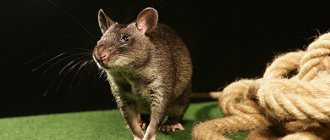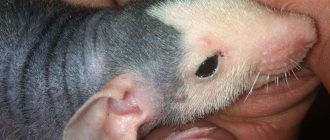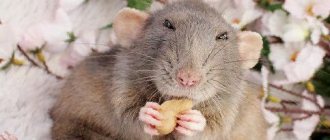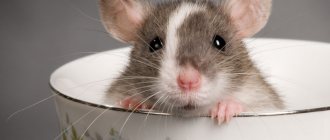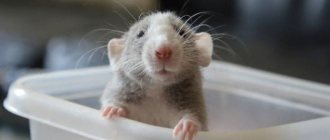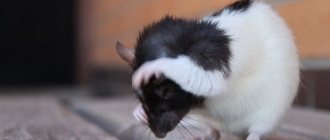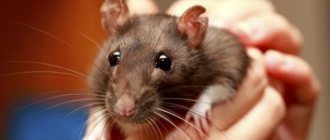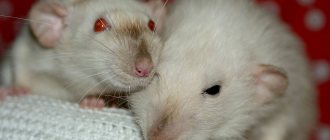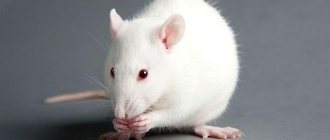The hairless decorative rat, as the name suggests, is a rat without hair. She looks just like any other rat, but instead of brown, white or black fur, she only has soft pink skin.
In fact, this animal is not completely naked. Some individuals, along with the bare pink surface of the skin, have areas of short dark hair along the body.
Description of a hairless rat
The Hairless breed was created in 1932 by mutation. The reason for the appearance of an unusual rodent was simple human curiosity. The animal is called the Sphinx rat, naked rat and bald rat . This is a rather rare phenomenon, which is distinguished by a hairless body, bright pink translucent skin, and a mustache of standard length.
Here are some interesting facts that clearly describe the bald man.
- He has a friendly character and a great mind. The pet expresses its affection in an interesting way. For example, he licks the owner’s hands. The temperament of an animal is determined by genetics.
- Lives up to 3 years, and with proper care - up to 5 years . Often these individuals die very early due to various diseases and human negligence.
- The body size of adult rats ranges from 15 to 25 cm, and body weight ranges from 350 to 700 g.
- The true Sphinx has bright pink skin, without scars or spots. It is soft and velvety to the touch. A slight folding of the skin gives the pet solidity and attractiveness. Today you can find hairless rats that are black, blue, chocolate, gray or cream in color.
- Vibrissae are located on the cheeks and above the eyes. The mustache curls slightly downwards, forwards or backwards. The size of the antennae is small when compared with the whiskers of standard rats. Some individuals do not have a mustache, which is considered a genetic deviation.
- Baldies are endowed with large, wrinkled, low-set ears. The eyes are bright and can be black, red, ruby, husky, or pink. There are individuals with different eye colors.
There is no hair. The recessive hairless gene is not observed in all rats. More often, individuals have partial hair.
Rats within the breed are divided into subspecies, depending on the areas of baldness, the shape and length of the whiskers:
- Hairless - hairless;
- Naked - naked;
- Fuzzy - fluffy;
- Nude - naked;
- Shorn - shorn;
- Bald - balding.
After birth, the offspring acquire a thick coat of fur. The fur coat is gradually falling out. It is possible to determine the subspecies of the animal only until the sixth week of the cub’s life.
Advantages and disadvantages of the breed
The hairless rat will be an ideal pet for children, lonely people and allergy sufferers. The main advantages of the breed are highlighted:
- absence of unpleasant odors;
- sociability, affection for a person;
- interesting external data;
- hypoallergenic properties;
- good mind.
Disadvantages include low life expectancy. The rodent will wither if left alone .
How to choose a cage?
A rat needs a cage because it needs a place to roam and play! It is important to choose a cage in which the animal will not be exposed to danger. There should be no sharp objects that could injure the pet. Size is also important: for one animal you need at least 70 cm, and for two, respectively, 140 cm.
Varieties of Sphinx rats
Sphinx on standard
This species was obtained by mutation and crossing of ordinary standard breed rats. Sphynxes have long mustaches and sparse hair on their heads, paws and sides. The animal's soft pink skin is intertwined with coarse dark hair. A distinctive feature of the animal is the presence of circles around the eyes . Rat breeders call them “porcupines” and “spectacled rats.”
Sphinx on a rex
The breed's hairless coats are descended from rodents with curly fur. Uniqueness lies in the presence of curled mustaches, sparse wavy hairs on the head, limbs and groin. Hair is absent during the molting period.
Sphinx on Double Rex
They are a sought-after breed of rat. Individuals are distinguished by completely hairless pink wrinkled skin. Bright eyes and large ears give the rodent a mystical appearance.
General health problems
Hairless rats have more potential health problems than their regular counterparts. They freeze quickly, and the lack of fur makes their skin extra sensitive. Some things that wouldn't bother a normal rat can scratch, cut, and otherwise irritate a hairless rat's skin. Despite the absence of hair, the animal has hair follicles. Sometimes they become clogged and form pimple-like bumps on the skin.
If not treated promptly, these bumps can become inflamed and cause an infection, which is likely to result in the death of the animal. The hairless rat has a weak immune system. Bacterial infections and other diseases are much more dangerous for her than for her ordinary counterparts.
With proper care and in almost ideal conditions, a hairless rat will live for about one year. The rat has such a short life because its body is unable to resist infections.
Rules for keeping a Sphinx rat
Place
The ideal place for a bald animal would be a large, cozy cage. Place the house in a secluded corner. It is important to exclude exposure of the rodent to drafts and sharp objects.
Correct temperature
The temperature in the room should be from +25 to +28 degrees.
Important! Dry air and too high temperatures destroy your pet's skin. It is recommended to humidify the room daily with spray bottles or special humidifiers.
Choosing a pet cage
To properly arrange a home for the Sphinx, just use these tips:
- buy a wire cage measuring at least 60x40x60 cm, equipped with a high plastic tray, a solid bottom and wide doors;
- an aquarium will create safer living conditions;
- inside the cage there is a swing, sticks, a wheel and a small house;
- large sawdust, white paper or cardboard are used as filler;
- a feeder and a drinking bowl are placed.
Before placing a pet in a new home, the cage is carefully inspected for damage and sharp corners.
Attention! It is not recommended to purchase a cage made of plastic or similar materials. After cleaning and disinfection, the material will be damaged and will release hazardous substances.
Cleaning
Clean the home once a week. The Sphinx is placed in a safe place so that the cage can be treated with disinfectants. After completing the procedure, rinse the house thoroughly under running water and dry. The drinking bowl and feeder are washed every day.
Do you groom the cage once a week?
Mandatory hygiene
Bathe your bald head once every few months. The frequency of water procedures depends on the cleanliness of the rodent. If your pet gets very dirty with food, you can bathe it once a week.
The container is filled with warm water and the rat is carefully placed in it. It is prohibited to use soap, shampoos, and other detergents. After washing, dry the Sphinx with a towel.
Hygienic procedures include trimming the claws. Special scissors and pruning shears are sold at pet stores. If a rat's claws are too long and sharp, it will scratch the other inhabitants of the cage.
Feeding
Hairless rats are barked often and in small portions. The Sphinx's favorite food is various nuts, vegetables and fruits. You can buy special food. You should not give your pet cheese, salty or fatty foods.
Group content
Sphinx lovers are advised to get a same-sex pair of animals at the same time. They will warm themselves against each other. Several individuals get along well in one area.
Important! Keeping a large number of hairless rats will not be difficult. One group is placed in a cage at a time. If pets are purchased in addition, it is better to place them in another cage. This will eliminate the aggressive behavior of the house owners towards new rats.
Communication
The Sphinx rat needs constant communication and games with its owner. Walk your pet in a safe room. The bald one will hide in the warm hands of a person and will closely observe the environment. If you trim the claws in a timely manner, the animal will not scratch its knees or shoulders while climbing.
Features of feeding
Most often, owners of hairless rats choose the most convenient way of feeding their pets - industrial grain mixtures.
Animals of this breed require a balanced diet of premium quality.
You can feed rats natural food, but at the same time:
- Avoid fatty foods.
- From time to time, add boiled fish, pieces of boiled meat, and boiled chicken bones to the diet.
- Regularly enrich your diet with vitamins.
Hairless rats should eat fractional meals. They need to be fed little and often. Sick animals should include special foods in their diet that act as natural antibiotics.
Table 2. Products for Sphynx rats
| Prohibited | Allowed with restrictions | Allowed/helping to recover from illness |
| Beans | Sour cream (once every 7–9 days) | Ripened bananas |
| Beans | Hard cheese (2–3 times a week) | Raspberries |
| Chocolate | Cookies (once a month) | Garlic |
| Raw potatoes | Sunflower and pumpkin seeds (2 pieces per day) | Eggplant |
| Cabbage | Sausage (once a month) | Tea infusion (with Echinacea) |
| Spinach | Bulb onions | |
| Unripe bananas | ||
| Carbonated drinks | ||
| Milk | ||
| Juices |
Attention! Salty and smoked foods, as well as sweets, must be excluded from the diet of hairless rats.
Breeding and reproduction
The Sphinx reaches maturity at 5 weeks of age. The young female is ready to mate 100 days after birth. The duration of pregnancy is 25 days. Hairless rats reproduce well: 8 to 12 pups are born in a litter. Zoologists recommend contacting a veterinarian before breeding Sphinxes.
The hairless rat cannot boast of maternal instincts. The owner must carefully monitor the mother's behavior. If she refuses to feed the offspring, then the owner must independently feed the pups with a special mixture.
Behavior and character
What does a hairless rat do during the day? When at home, inside the cage, she likes to play from time to time. She would appreciate the presence of another rat as a companion - any kind: regular or hairless. Most hairless rats are happiest when they have a companion inside their cage to bask against each other. What could be better than cuddling with someone at night and going to sleep?
The rat loves toys, but it does not require anything special, so at the pet store you can choose whatever you like best for it. Change toys every day or every other day to satisfy your animal's curiosity.
Health and illness
Sphynx rats are susceptible to:
- acute respiratory diseases - the pet makes sounds similar to coughing;
- abscesses - purulent formations on the skin are observed;
- cardiovascular diseases - the animal is weak and inactive, obesity appears;
- skin diseases - there are rashes, wounds and scabs on the body;
- benign tumors and oncological diseases - the animal languishes, refuses to eat and drink.
After birth or purchase, the hairless rat is taken to the veterinarian. If minor deviations in the pet’s behavior are observed, it is important for the owner to immediately contact a specialist.
Nutrition and diet
Rats love to eat and, as a result, will, of course, overeat if given the opportunity. They can become overweight and fat extremely quickly. It is important to carefully choose food for your pet friend and monitor the amount of food eaten.
The hairless rat looks cute even when he's a little chubby, but his health is at stake in this matter. Hairless rats eat the same food as normal rats. Choose a food that will provide your pet with the vitamins and nutrients it needs to stay healthy.
Fruits are a treat and hairless rats certainly love them. They even enjoy vegetables and nibble on them from time to time. Offering your rat a few pieces of fresh fruit and vegetables every day will help keep him in good health and enjoy variety.
If you kill an attacking rat with your bare hands, no human is scary anymore
The interview was given by GRU special forces officer Sergei Nikolaevich Badyuk. Born on July 3, 1970 in the Shargorod district of the Vinnitsa region of Ukraine. In 1988-1990 served in the 8th separate special forces brigade of the GRU. After finishing his service, he entered the KGB Higher School, continuing his service in the FSB of Russia. Master of martial arts of Russia, holder of 8th dan in Kyokushinkai-budokaikan karate, 5th dan of IKO, master of sports of the USSR in kettlebell lifting and hand-to-hand combat. Conducts master classes in hand-to-hand combat at the Academy of the FSB of Russia.
Conscripts are recruited into special forces with the note: “Fit for the Airborne Forces.” These are physical conditions slightly above average (height does not matter) and (preferably) at least the first category in applied military sports: running, parachuting, shooting or hand-to-hand combat. Well, since the main task of the GRU is reconnaissance, and the main muscle of an intelligence officer is the head, it is welcome if you have improved it at school, college or institute. In addition, a special forces soldier must have five basic qualities. The Main Intelligence Directorate (GRU) of the General Staff of the Armed Forces of the Russian Federation dates back to 1918. Engaged in all types of intelligence in the interests of the Armed Forces - intelligence, space, radio-electronic. The number and budget are classified. The GRU special forces were created in 1950, the tasks of the units are reconnaissance deep behind enemy lines, counterintelligence, sabotage activities, and the destruction of terrorists. GRU special forces units played a huge role in the Afghan war and in operations in Korea, Angola, Nicaragua, and the Chechen Republic. At the moment, it is the most closed and, perhaps, the most combat-ready unit of the Russian Armed Forces.
Caution Intelligence has the right to select a soldier from any unit. When we recruit soldiers for special forces, we make sure to ask the fighter a question - what does he need in special forces? If he wants to become a Hero of Russia, we send him to such and such a mother. No, he will definitely become a hero, but posthumously. And he will bury the whole group with him. Recklessness is only needed when you're pushed against the wall. Then with a shout of “Hurray!” took the machine gun and ran to die. Victory is when you quietly complete the task and return alive. From the first day, a soldier who ends up in special forces begins to hammer into his head (with words, hands, feet) the main commandment: you are the coolest of all. This is an important moment of psychological preparation. And you will believe it. If not, they will send you to serve in the infantry. You shoot around the clock, run like a horse, and are constantly beaten. They do not beat in the sense of hazing and lawlessness that is happening in the army. There are no “bring-and-give” things. You just move around the barracks as if it were enemy territory. Either they can slap you across the head, or they will mine the bed - they will put a tripwire, or they will put a noose around your neck. These are our jokes. This is fine. It makes you think, listen, watch, be on alert. People quickly learn from touching unfamiliar or bright things: there’s a keychain with keys on the table, and under it there’s an improvised explosive device; if you grab the keys, you may lose your hand. After six months of service, not only do your eyes grow in the back of your head, you even sleep so lightly that just looking at you wakes you up. I'm still waking up.
Endurance A paratrooper's bread is his legs. Because from the moment the reconnaissance group is spotted, according to statistics, after 6 hours they will catch up with it and destroy it. Are you exhausted? You remain to cover the entire group. I know a case when, in a combat situation, a guy said that he could no longer run. They left him almost all the ammunition and ran on. This is how they become heroes. You don't have to be a master of hand-to-hand combat, but you have to run like a race mare. During the first month in special forces, a soldier sleeps for 4 hours - less is allowed according to the regulations. The remaining 20 hours he works hard. Wake up at 6 am. They calmly let you get up, wash, and stretch. There is no need to believe films, there is no rush in the spirit of “getting yourself in order while the match is burning.” Then they put on their backpacks and ran. It’s lazy, the main thing is not to take a sporty step. Lazy does not mean calm. The commander constantly gives introductory tasks. Either we have ambushes or shooting, so the running is always in a ragged rhythm: with somersaults, crawling, and goose-stepping. After the run - physical training, special tactical exercises, hand-to-hand combat. And so every day. The endurance and mental stability of a soldier who deigns to serve in the GRU special forces is tested “at the races.” Horse racing looks like this. A group of soldiers are driven into the forest for 7-8 days without provisions. The commanders, who change every 12 hours, drive the soldiers through the forest and do not allow them to sleep at all. Until loss of consciousness, vomiting and other joys. Those who could not stand it are sent “outside the fence,” that is, into the combat troops. This way a lot of people are eliminated. The races are held every six months, it's like an exam.
Determination When, while going out into the forest, a group of recruits begin to be shot from the bushes with blank cartridges, panic begins among the soldiers. It's treatable. The best cure for panic is hand-to-hand combat training. The fighter is dressed in protection, put against an order of magnitude stronger and more experienced fighter - and beaten. This is how a fighting character and determination to go to the end are formed. Do not confuse this with hazing; a soldier is always given the opportunity to fight back. Even so: a soldier who does not fight back is sent “beyond the fence.” The peculiarity of special forces hand-to-hand combat is that any fight comes down to one thing - destroying the enemy. We don’t have operations to detain dangerous criminals, we have a war. Hence the special forces motto: “Only idiots fight with their bare hands.” First of all, soldiers are taught to use available means: a machine gun, a knife, sticks, stones, fragments of bottles, pieces of glass, tightly rolled newspaper. Right now we are sitting in a cafe, talking. Before me are two deadly weapons - my beer mug and your teapot. First I will scald your face with tea, then I will hit your temple with a blow to your head with this teapot. It’s even easier with a mug: you break it on the table and cut your neck with the broken edge. We have one task - to inflict fatal wounds, and this is precisely the head and neck area. And only then, when all the basic necessities have been mastered, a very compact set of striking equipment is trained. In addition to hand-to-hand combat, special forces have a whole series of “audacity exercises.” In our unit, for example, they used exercises with a rat. A large rat was thrown into the washbasin and a naked fighter was locked in with it. The goal of such a date is to strangle the rat. When the rat has nowhere to go, it begins to attack. And this is real tough. In short, if you can nail it with your bare hands, no person is afraid of you anymore.
Aggression The main thing in a soldier is aggression. The special forces soldier fears the sergeant more than the enemy. And he runs towards the enemy with a clear desire to devour him. During hand-to-hand combat training, there is blood. The sergeants deliberately injure the soldier. A fighter must get used to blood, let’s say, become a Satan. You're probably used to working out in the gym to energetic music? For a fighter, the best soundtrack is the three-story mat of his commander. In a state of such severe pressure, feelings become so acute that everything invested in a soldier in six months remains with him for the rest of his life. It’s not like you go to training in light mode for 15 years and then become a world champion. The paratrooper is immersed in a state of war and made to feel a real threat to his life - and this is his advantage. Here is the answer to the question: Why the hell do they call in a company of riot police to calm down three drunken paratroopers? The secret is psychological readiness to kill a person. There is, of course, an important social problem here. Objectively, what our country does not have are rehabilitation centers after the army. We fulfill our task, we prepare a fighter, he serves, but upon returning home, he cannot adapt to peaceful life.
Cleanliness Special forces are paranoid about hygiene. Since reconnaissance is constantly outside the deployment point, fighters are required to keep themselves clean in any conditions. Any fighter, upon arriving at the location, must first wash his uniform and change into clean clothes. No matter what crap you crawl through, be kind enough to put yourself in order after completing the task. I don’t remember any of our fighters ever being sick. Apparently, this is also due to the psychological mood. There was a story when I, still a young soldier, was accidentally cut in the head with a grenade launcher during a training session. I, wounded and covered in mud, was dragged through the swamp for two hours. We went out to the river, washed our hair, bandaged it - and that’s it, no infection for you. Contrary to logic, soldiers don’t get sick—there’s no time!
TRAINING PRINCIPLES The majority of the time a special forces soldier is away from permanent deployment points. Accordingly, all physical training is based on using available means during training. The main thing in training is to develop endurance and maintain strength qualities for as long as possible. And if you haven’t guessed it yourself, endurance will come in handy, say, when you’re going to the mountains or on a bike ride. So, the training is daily, the course is not designed, as usual, for six or eight weeks. You will need to work for at least a year. You will be surprised, but when I joined the army, I weighed 86 kg (I am 190 cm tall), and three months later the scales showed 103 kg! And all this is within the framework of the program that is now in front of you. And yes, the special forces soldier has only one diet - eat more. The preparation of a fighter is based on four pillars: 1. Jogging and crawling 10 km every day. On Sundays we sometimes have a “sports holiday” - run 40 km. But while you are not in the army, you can rest on Sunday. Remember, a fighter runs 10 km in less than an hour in full gear (additional 50 kg). Running should be alternated with crawling. They work well on small muscle groups and ligaments. There are three ways: on the prone, on the back and passing through a minefield (the fighter lay down, felt the irregularities with his hands, pulled himself forward, felt the irregularities again. If something on the surface causes suspicion, he moves to the side).
2. Circular training At the Ryazan Airborne School at the special department of physical training, they proved that circuit training provides the highest level of strength endurance. The principle was borrowed from the Soviet school of boxing and sambo. Circuit training develops endurance, explosive strength, “dries out” and develops anger towards the authorities. The number of repetitions in any exercise is until the sergeant gets bored. A standard workout takes 40 minutes. After the aforementioned 10-kilometer run, rest for 5 minutes, then do 5-6 circles in which the exercises are performed one after another without rest. Rest between circles - 5 minutes. A standard special forces circle looks like this:
- Finger push-ups (20 reps)
- Jump (10 reps)
- Fist push-ups (30 reps)
- Jump (10 reps)
- Finger push-ups (5 reps)
- Jump (10 reps)
- Fist push-ups (30 reps)
At the end of each circle, pump the abs to failure. You can also include rock throwing training.
3. Constant load There is one principle in the army - constant daily load. That is, per day you must do a certain (constantly growing) number of push-ups with your fists, a certain number of press exercises, wide-grip pull-ups, etc. If you can’t do it in one workout, gain the amount in a day. This is constant combat readiness. In addition, during the day, perform isometric exercises with a belt according to the Alexander Zass system.
4. Hand-to-hand combat Hands Side left and side right from boxing technique. Direct punches are very difficult to teach to hit hard; in all my service I have almost never seen fighters who punch straight well. Such a strike requires the highest level of preparation. We proceed from the fact that we need to quickly and well prepare a fighter. Since there are no restrictions, this side kick can be combined with a bunch of varieties and options. He fights from all positions and angles. Moreover, it is advisable to first strike the enemy in the throat. In close combat we hit with our elbows. We train knockout power with exercises with a sledgehammer (see photo) Legs The entire technique of kicking in special forces comes down to one thing - a strong blow to the groin. This is not a sports ground for you. Head We turn on the head (and turn off the brain for a while) in close combat. We hit the upper frontal part exclusively on the nose. When grabbed from behind, we hit the nose with the back of the head. Stalling This is what strength and grip are trained for. Knocked down an opponent using arm strength - hit the back of the head like a soccer ball, or step on the throat.
Comfortable living conditions
The Sphynx is a breed that is sensitive to the effects of heat and ultraviolet radiation, especially in the head area. Therefore, her cage should not be in direct sunlight.
Cell selection
The pet's cage should be spacious and large enough. There is no need to leave sharp objects near it and avoid direct sunlight. Hairless rats grow hair solely due to the activation of the body's protective functions. Create good conditions and the “fouling” problem will be solved!
Cleaning the cage
Speaking about sphinxes, it should be noted that they are quite clean creatures. During cleaning, you need to remove garbage from the cage, wash and disinfect the surface. This will not only get rid of the rodent smell in the house, but also prevent many diseases.
Advantages and disadvantages of the breed
The hairless pet rat is rapidly gaining popularity and this is due to a fairly large list of advantages compared to disadvantages. This pet is ideal for families with small children, as well as for people with allergies.
How much does a pet rat cost - cost of keeping
The main advantages of the breed and keeping the rodent:
- The hairless rat breed is completely hypoallergenic. That is why people who are prone to developing allergic reactions due to fur should pay attention to rats.
- Animals have a good disposition, so people living with them receive a lot of positive emotions. They are pleasant to the touch and really love to spend time in the arms of their owners.
- The process of adaptation to a new home takes a short period of time, since the animals quickly become attached to new people and crave communication with them. An interesting feature of the life of bald rat pups is that they love to watch the life of their household members from above, climbing onto their shoulders.
- Due to the lack of fur, the animals do not emit a pleasant smell, and they are also very clean animals. The main thing for the owner is to regularly clean the “rat” toilet.
- Decorative rats love water very much, so they will happily swim in warm water. Do not use additional detergents.
- Caring for hairless rats has no fundamental differences in comparison with ordinary breeds of these animals. Perhaps the only condition is that due to the lack of wool, the room must have an optimal temperature range, ranging from +22 to 30 degrees. If several pets live in a cage, the temperature may be slightly lower.
Note! It has been scientifically proven that Sphynx rats are smart and easily remember their name and the names of other pets. Remember the names of all household members.
Appearance of Sphynx rats on a rex
As for the disadvantages, it is worth noting only their short life expectancy. Hairless rats also quickly waste away when left alone.
How to call a baby rat diminutively
Any nickname, be it from the flower or gastronomic category, can be made affectionate:
- Cheese - cheese
- Red - saffron milk cap
- Baby doll - baby doll
- Baby - baby - baby
- Nut - nut
- Cherry - cherry
This way you can use a lot of nicknames to show love and praise to your pet.
Funny nicknames
It's funny to hear nicknames taken from famous personalities or popular brands:
- Napoleon
- Klepa - Cleopatra
- Jobs
- Newton
- Nostradamus
- Churchill
- Clinton
- Prado
- Zara
- Lacoste
Names of book characters by their authors and computer games
Let’s remember your favorite book, author or game, you can easily choose a nickname:
- Twain
- King
- Grimm
- John
- a lion
- Lem
- Faust
- Romeo and Juliet
- Nancy
- Drew
- Margarita and the Master
- Snobby
- Mu Mu
- A little prince
- Cinderella
- Alice
- Glover
- Desdemona
- Pocahontas
- Mowgli
- Kaa et al.
A name for a decorative rat with a musical touch
If you take the name or lead singer of any group, you also get a wide choice for choosing a name for your pet:
- Pink
- Aria
- Ozzy
- Mens
- Duran
- Marley
- Pompey
- Rami
- Michael
- Sinatra
- Elvis
- Flint
- Kurt
- Jackson
What to feed a rat
The pet's health largely depends on the Sphynx's diet. In order for the rat to develop normally and always feel good, you will need to organize a balanced diet for it, taking into account the following recommendations:
- The menu should be based on specialized grain feed. In this case, it is better to choose premium or super-premium products.
- The diet must be varied with natural products: succulent food (fresh herbs, fruits, vegetables), protein products (cottage cheese, kefir, fermented baked milk, lean meat, eggs, fish), nuts, seeds.
- To strengthen internal organs and the immune system, you need to add a few special vitamin and mineral complexes to the feeders.
- From time to time, the rat is allowed to pamper with treats for rodents - grain cookies, tasty fruit sticks, dried carrots, pine cones.
- To ensure normal metabolism, you need to provide the rat with plenty of fluids. To do this, it is enough to install at least 2 drinkers in the cage.
It is also necessary to exclude some harmful foods from the Sphynx's diet: candies, chocolate, carbonated drinks, baked goods, potatoes, fatty and fried meats, sour, hot, spicy dishes, fresh milk.
It is recommended to place 2 feeders at once in a rat cage. One is for industrial feed, the other is for natural food.
You need to feed your Sphynx often, but little by little. Small meals will ensure good metabolism. It will also help improve intestinal motility.
Care and maintenance
Since the skin of rats is very sensitive to environmental conditions, before purchasing a pet you will need to take care in advance of organizing an appropriate microclimate in the room with the cage. Particular attention should be paid to the temperature regime - in order for the animal not to freeze, the air temperature in the room should be +23-27ᵒC. It is also necessary to curtain the windows so that the sun's rays do not fall on the animal. Humidity should be 55-65%.
The following requirements apply directly to the animal cage:
- Sphynx rats are active animals, so it is better to buy multi-tiered cages for them; you also need to install several equipment inside for exercise: ladders, ropes, a running wheel, tunnels;
- rats need their own cozy corner where they can retire or just relax - for these purposes, a special house should be equipped inside the home;
- The cage must have a removable tray; it is recommended to fill it only with natural materials, for example, sawdust or shredded toilet paper.
